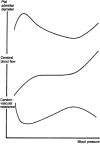Losing the dogmatic view of cerebral autoregulation
- PMID: 34323023
- PMCID: PMC8319534
- DOI: 10.14814/phy2.14982
Losing the dogmatic view of cerebral autoregulation
Abstract
In 1959, Niels Lassen illustrated the cerebral autoregulation curve in the classic review article entitled Cerebral Blood Flow and Oxygen Consumption in Man. This concept suggested a relatively broad mean arterial pressure range (~60-150 mmHg) wherein cerebral blood flow remains constant. However, the assumption that this wide cerebral autoregulation plateau could be applied on a within-individual basis is incorrect and greatly variable between individuals. Indeed, each data point on the autoregulatory curve originated from independent samples of participants and patients and represented interindividual relationships between cerebral blood flow and mean arterial pressure. Nonetheless, this influential concept remains commonly cited and illustrated in various high-impact publications and medical textbooks, and is frequently taught in medical and science education without appropriate nuances and caveats. Herein, we provide the rationale and additional experimental data supporting the notion we need to lose this dogmatic view of cerebral autoregulation.
Keywords: Lassen; arterial blood pressure; autoregulatory curve; cerebral autoregulation; cerebral blood flow.
© 2021 The Authors. Physiological Reports published by Wiley Periodicals LLC on behalf of The Physiological Society and the American Physiological Society.
Conflict of interest statement
The authors declare no conflict of interest.
Figures




References
-
- Abercrombie, J. (1836). Pathological and practical researches of diseases of the brain and spinal cord, 3rd ed. John Carfrae and Son.
-
- Barrett, K. E. , Barman, S. M. , Boitano, S. , & Brooks, H. (2010). Ganong's review of medical physiology, 23rd ed. McGraw‐Hill.
Publication types
MeSH terms
LinkOut - more resources
Full Text Sources
Other Literature Sources

